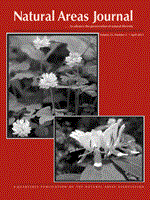To investigate the hypothesis that Frangula alnus, glossy buckthorn, is causing a decrease in native plant diversity in forested plant communities of southwest New Hampshire, thirty nine 20-m × 20-m plots were established in five different forest types, and all buckthorn saplings and seedlings were removed from 15 of the plots. A nested plot design was used to sample shrubs and herbs. Treatment plots were kept free of buckthorn for five years. There was a positive relationship between pre-treatment buckthorn density and percent openness of the forest canopy, and with basal area of white pine (Pinus strobus), but not with soil wetness indicators. No significant changes in overall plant diversity or stem density were detected after buckthorn was removed, although stem density of woody plants, and seedlings of Acer rubrum did show significant increases in the treatment plots when compared to controls, but these effects were only seen in areas with the highest densities of buckthorn. No effects of buckthorn were observed below an average of 8.25 stems per m2. Compared to other areas of the northeastern United States, the densities of buckthorn were very low. Buckthorn seedling densities showed small increases in the control and monitoring plots, perhaps indicating a slow build-up to a “threshold” density, beyond which greater impacts on native species may be seen.
How to translate text using browser tools
1 July 2013
Effects of Moderate Densities of Glossy Buckthorn on Forested Plant Communities in Southwest New Hampshire, USA
Catherine Owen Koning,
Rhine Singleton
ACCESS THE FULL ARTICLE

Natural Areas Journal
Vol. 33 • No. 3
July 2013
Vol. 33 • No. 3
July 2013
forest management
Frangula alnus
glossy buckthorn
invasive species




